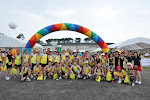LONDON (Reuters Life!) - The hardest thing about my running of this year's London marathon was not hitting the wall after 20 miles but having to endure the "encouragement" of fellow runners and supporters when I started walking after one.
I didn't become possibly the first of 32,000 participants to stop running because I was tired or suffering cramp but because I wanted to minimize both later in the race.
But the fact that walking one minute of every 10 would also help me to a faster time than running all the way was the driving force behind my experiment with the "walk-break" method.
The concept sounds counter-intuitive at least, barmy at worst, but its chief protagonist, American Jeff Galloway, has made a career out of promoting it.
The basic theory is that the key muscles and tendons involved in running get such regeneration from the brief rest afforded during the walk break that you are able to run faster overall than when trying to plod the entire distance.
Instead of joining the mass of cramped, suffering participants forced to walk the last few miles after their bodies have given up, you take you breaks early and often.
With the added mental bonus of breaking the race down into mini-targets of nine minutes, ideally you finish strong and fresh with the not inconsiderable benefit of recovering much more quickly.
Putting it into action though takes some self-discipline. Amid the adrenalin rush of the early stages of a big-city marathon it's not easy to duck onto the path before you've broken sweat, smiling benignly at the bemused onlookers calling out "come on mate, you can do it, only 25 miles to go."
But, having posted a time of three hours 16 minutes - 14 minutes inside my target and finishing with my fastest two kms of the race - I have become such a convert that my friends and club mates have introduced a conversational "Jeff ban" when out running with them.
A self-confessed "very average" runner in his teenage years Galloway improved rapidly enough to represent his country in the 10,000 meters at the 1972 Olympics.
He then concentrated more on the marathon - he has completed more than 120 editions of the classic distance - and coaching.
Author of more than a dozen books, beginning with the huge-selling "Galloway's Book on Running," nowadays he spends his time criss-crossing the United States and beyond giving seminars and motivational speeches (www.jeffgalloway.com).
From advising a few keen runners visiting his running store almost 40 years ago, Galloway, 64, now coaches tens of thousands of athletes via his seminars and the web.
He stumbled across the system that was to define much of his adult life when he began training a group of 22 novice runners in 1973.
"Most of them did a lot of walking in their training and when they all completed their five and 10km target races without any injuries, which was very unusual, I realized that the walking was key, Galloway told Reuters in a telephone interview from his base in Atlanta.
"The method quickly evolved, I developed different ratios for different levels of fitness and different target times. Someone aiming to break three hours can benefit in the same way as somebody just hoping to finish.
"The body is not designed for continuous running for long distances so it is all about the conservation of resources."
Galloway turned Guinea pig when he stopped running competitively and realized he needed a way to continue to be able to enjoy the sport injury-free.
The result of his walk-break approach was a personal best marathon of 2:16 at the age of 35.
"I never doubted that it worked but that strengthened my conviction," he said.
Not everyone thinks Galloway has got it right and there is something of a backlash by some in the sport who scoff at the lack of quantifiable evaluation of his approach and others who consider it somehow "impure" to choose to walk - presumably deeming it acceptable to do so through fatigue at the end.
"There is always going to be skepticism, it's the way of the world, but I'm not forcing anyone to try my method," Galloway said.
"I get around 100 emails a day. About 30 percent are from people with a question and the rest are from satisfied customers."
(Editing by Paul Casciato)
http://in.reuters.com/article/lifestyleMolt/idINTRE58F4BQ20090916?sp=true




























































